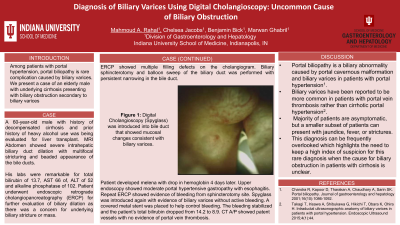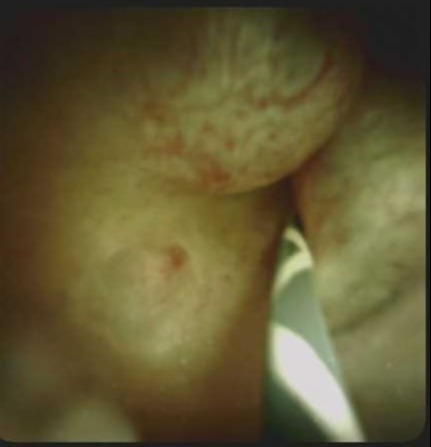Back


Poster Session D - Tuesday Morning
Category: Biliary/Pancreas
D0076 - Diagnosis of Biliary Varices Using Digital Cholangioscopy: Uncommon Cause of Biliary Obstruction and Bleeding
Tuesday, October 25, 2022
10:00 AM – 12:00 PM ET
Location: Crown Ballroom

Has Audio

Mahmoud Rahal, MD
Indiana University School of Medicine
Indianapolis, IN
Presenting Author(s)
Award: Presidential Poster Award
Mahmoud Rahal, MD, Chelsea Jacobs, DO, Benjamin Bick, MD, Marwan Ghabril, MD
Indiana University School of Medicine, Indianapolis, IN
Introduction: Portal biliopathy is one of the rare complications of cirrhotic portal hypertension. We present a case of a patient with underlying cirrhosis presenting with biliary obstruction and bleeding in setting of biliary varices.
Case Description/Methods: A 60-year-old male with history of decompensated cirrhosis and heavy alcohol use was admitted for inpatient evaluation for liver transplant. His labs were remarkable for total bilirubin of 13.7, AST 66 of, ALT of 52 and alkaline phosphatase of 102. Patient reported several days of melena prior to admission but hemoglobin remained stable and there was no evidence of bleeding after admission. MRI abdomen completed as part of his pre-transplant workup showed severe intrahepatic biliary duct dilation with multifocal stricturing and beaded appearance of the bile ducts. Patient underwent endoscopic retrograde cholangiopancreatography (ERCP) for further evaluation. ERCP showed multiple filling defects on the cholangiogram that disappeared with contrast injection. Biliary sphincterotomy and balloon sweep of the biliary duct was negative other than blood clots. The filling defects remained in place despite multiple sweeps. Digital cholangioscopy (Spyglass) was introduced into bile duct that showed mucosal changes consistent with biliary varices. Four days post-procedure the patient developed melena with acute anemia. Repeat ERCP showed evidence of bleeding from sphincterotomy site and again biliary tree sweep revealed intraductal blood clots. Spyglass was introduced again with evidence of biliary varices without active bleeding. A covered metal stent was placed to help control post-sphincterotomy bleeding. The bleeding stabilized and the patient’s total bilirubin dropped from 14.2 to 8.9 over the following three days. CT A/P showed patent vessels with no evidence of portal vein thrombosis.
Discussion: Portal biliopathy is a biliary abnormality caused by portal cavernous malformation and biliary varices in patients with portal hypertension1. Biliary varices have been reported to be more common in patients with portal vein thrombosis rather than cirrhotic portal hypertension2,3. Majority of patients are asymptomatic, but a smaller subset of patients can present with jaundice, fever, or strictures. This diagnosis can be frequently overlooked which highlights the need to keep a high index of suspicion for this rare diagnosis when the cause for biliary obstruction or bleeding in patients with cirrhosis is unclear.
References are available per request.

Disclosures:
Mahmoud Rahal, MD, Chelsea Jacobs, DO, Benjamin Bick, MD, Marwan Ghabril, MD. D0076 - Diagnosis of Biliary Varices Using Digital Cholangioscopy: Uncommon Cause of Biliary Obstruction and Bleeding, ACG 2022 Annual Scientific Meeting Abstracts. Charlotte, NC: American College of Gastroenterology.
Mahmoud Rahal, MD, Chelsea Jacobs, DO, Benjamin Bick, MD, Marwan Ghabril, MD
Indiana University School of Medicine, Indianapolis, IN
Introduction: Portal biliopathy is one of the rare complications of cirrhotic portal hypertension. We present a case of a patient with underlying cirrhosis presenting with biliary obstruction and bleeding in setting of biliary varices.
Case Description/Methods: A 60-year-old male with history of decompensated cirrhosis and heavy alcohol use was admitted for inpatient evaluation for liver transplant. His labs were remarkable for total bilirubin of 13.7, AST 66 of, ALT of 52 and alkaline phosphatase of 102. Patient reported several days of melena prior to admission but hemoglobin remained stable and there was no evidence of bleeding after admission. MRI abdomen completed as part of his pre-transplant workup showed severe intrahepatic biliary duct dilation with multifocal stricturing and beaded appearance of the bile ducts. Patient underwent endoscopic retrograde cholangiopancreatography (ERCP) for further evaluation. ERCP showed multiple filling defects on the cholangiogram that disappeared with contrast injection. Biliary sphincterotomy and balloon sweep of the biliary duct was negative other than blood clots. The filling defects remained in place despite multiple sweeps. Digital cholangioscopy (Spyglass) was introduced into bile duct that showed mucosal changes consistent with biliary varices. Four days post-procedure the patient developed melena with acute anemia. Repeat ERCP showed evidence of bleeding from sphincterotomy site and again biliary tree sweep revealed intraductal blood clots. Spyglass was introduced again with evidence of biliary varices without active bleeding. A covered metal stent was placed to help control post-sphincterotomy bleeding. The bleeding stabilized and the patient’s total bilirubin dropped from 14.2 to 8.9 over the following three days. CT A/P showed patent vessels with no evidence of portal vein thrombosis.
Discussion: Portal biliopathy is a biliary abnormality caused by portal cavernous malformation and biliary varices in patients with portal hypertension1. Biliary varices have been reported to be more common in patients with portal vein thrombosis rather than cirrhotic portal hypertension2,3. Majority of patients are asymptomatic, but a smaller subset of patients can present with jaundice, fever, or strictures. This diagnosis can be frequently overlooked which highlights the need to keep a high index of suspicion for this rare diagnosis when the cause for biliary obstruction or bleeding in patients with cirrhosis is unclear.
References are available per request.

Figure: Image of biliary varices noted during digital cholangioscopy procedure
Disclosures:
Mahmoud Rahal indicated no relevant financial relationships.
Chelsea Jacobs indicated no relevant financial relationships.
Benjamin Bick indicated no relevant financial relationships.
Marwan Ghabril indicated no relevant financial relationships.
Mahmoud Rahal, MD, Chelsea Jacobs, DO, Benjamin Bick, MD, Marwan Ghabril, MD. D0076 - Diagnosis of Biliary Varices Using Digital Cholangioscopy: Uncommon Cause of Biliary Obstruction and Bleeding, ACG 2022 Annual Scientific Meeting Abstracts. Charlotte, NC: American College of Gastroenterology.

